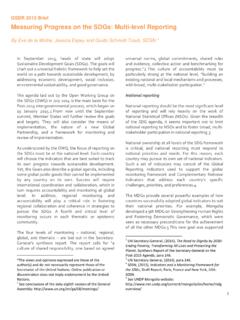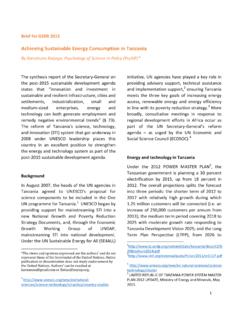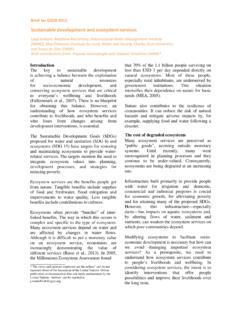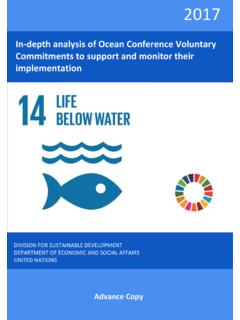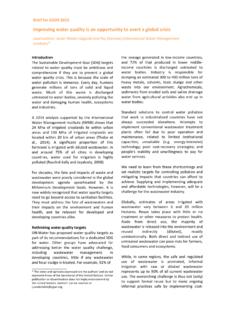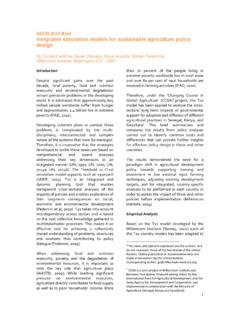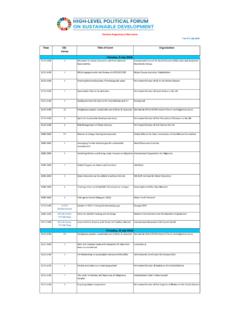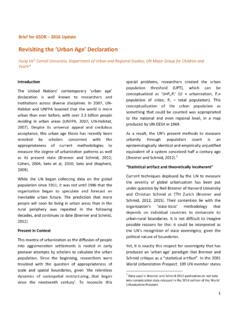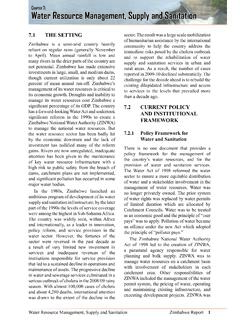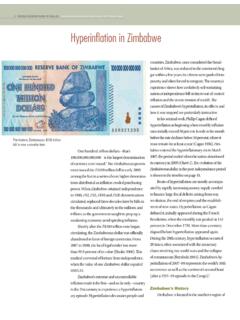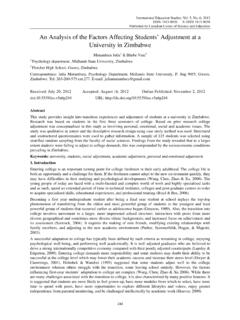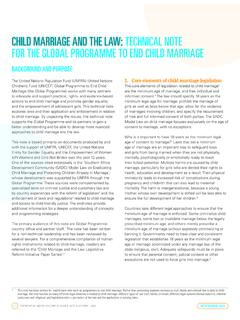Transcription of Renewable Energy in Africa: Prospects and Limits
1 Renewable Energy in africa : Prospects and Limits Republic of Senegal United Nations Renewable Energy DEVELOPMENT. Prepared by Stephen Karekezi Director, African Energy Policy Research Network (AFREPREN). and Waeni Kithyoma, AFREPREN. for The Workshop for African Energy Experts on Operationalizing the NEPAD. Energy Initiative Operationalizing the NEPAD Energy Initiative 2- 4 June, 2003. Novotel, Dakar, Senegal ii Table of Contents Executive Summary Introduction Status of the Energy sector Current contribution of Renewable Energy to the Energy Sector Status and Prospects of Renewables in africa Large Scale Renewable Energy Technologies Small Scale Renewable Energy Technologies Barriers to the adoption of RETs in africa Policy and legal barriers Technical barriers Financial barriers Overcoming the barriers to the adoption of Renewables in africa Policy and legal frameworks Appropriate technology, technology transfer and building local capacity Innovative Financing Mechanisms The Clean Development Mechanism Opportunities for africa The Way Forward Renewables in the NEPAD Energy Initiative References Acknowledgements: The authors would like to thank the following individuals at the AFREPREN Secretariat for their valuable inputs into the compilation of this paper.
2 Jennifer Wangeci, Anthony Maina, Amos Mutiga, Geoffrey Muthee, Ayago Wambile and Linet Ojiambo. iii Executive Summary: africa has substantial new and Renewable Energy resources, most of which are under-exploited. Only about 7% of africa 's enormous hydro potential has been harnessed. Existing estimates of hydro potential do not include small, mini and micro hydro opportunities, which are also significant. Geothermal Energy potential stands at 9000MW, but only about 60MW has been exploited in Kenya. Estimates further indicate that a significant proportion of current electricity generation in 16 Eastern and Southern African countries could be met by bagasse-based cogeneration in the sugar industry. Based on the limited initiatives that have been undertaken to date, Renewable Energy technologies (RETs) could contribute significantly to the development of the Energy sector in eastern and southern African countries.
3 Renewable Energy technologies (RETs) provide attractive environmentally sound technology options for africa 's electricity industry. RETs could offset a significant proportion of foreign exchange that is used for importing oil for electricity generation in most countries. In addition, renewables are modular and are well suited for meeting decentralized rural Energy demand. The modular nature ( can be developed in an incremental fashion) of most Renewable Energy technologies and the low investment levels makes them particularly suitable for capital-constrained African countries. Most Renewable Energy technologies utilize locally available resources and expertise, and would therefore provide employment opportunities for the locals. The success of RETs in the region has been limited by a combination of factors which include: poor institutional framework and infrastructure; inadequate RET planning policies; lack of co-ordination and linkage in the RET programme; pricing distortions which have placed Renewable Energy at a disadvantage; high initial capital costs; weak dissemination strategies; lack of skilled manpower; poor baseline information; and, weak maintenance service and infrastructure.
4 The following policy options could contribute to the development and dissemination of successful RETs programs in the region: Long term RETs policy programmes within government Careful selection of RETs that are appropriate to africa , and implementation of sustained capacity building programs Instituting innovative financing mechanisms and tapping into financing opportunities such as CDM. and micro-credit institution. To ensure that africa 's Energy community is able exploit the unique opportunity that NEPAD provides for the development of renewables in africa , the following multi-pronged strategy is proposed: A near-term fast track program (1-5 years) that would aim to implement low-risk and low-cost near term initiatives. A long-term track program (5-10 years) that is built around major Renewable Energy sector initiatives that are currently taking place. 1. 1. Introduction Status of africa 's Energy Sector africa 's Energy sector is best understood as three distinct regions.
5 North africa , which is heavily dependent on oil and gas, South africa , which depends on coal and the rest of Sub-Saharan africa , which is largely reliant on biomass (Karekezi, 2002a). Figures for Eastern and Southern African countries indicate that a high proportion of total national Energy supply is derived from biomass Energy (Figure 1). Biomass Energy , which refers to a wide range of natural organic fuels such as wood, charcoal, agricultural residues and animal waste, is often used in its traditional and unprocessed form. Even oil-rich sub- Saharan African countries continue to rely on biomass Energy to meet the bulk of their household Energy requirements: in Nigeria, it is estimated that about 97% of the household Energy needs are met by biomass (IEA, 2001). Figure 1: Biomass Energy as a percentage of total Energy for selected Eastern and Southern African countries 100. 90. Biomass % of Total Energy 80. 70.
6 60. 50. 40. 30. 20. 10. 0. Namibia Mozambique Ethiopia Uganda Tanzania Eritrea Sudan Madagascar Angola Malawi Kenya zimbabwe S. africa Bostwana Source: AFREPREN, 2002. Traditional biomass Energy use has serious environmental drawbacks. The indoor air pollution from unvented biofuel cooking stoves is a major contributor to respiratory illnesses in highland areas of sub- Saharan africa . Reliance on biomass (especially in the form of charcoal) also encourages land degradation. In some areas, for example around major cities like Lusaka, Zambia Dar-es-Salaam, Tanzania and Nairobi, Kenya, charcoal demand appears to contribute to degradation of the surrounding woodlands and forests (Karekezi, 2002a, Kantai, 2002). Consumption of modern Energy in sub-Saharan africa (excluding south africa ) is very low. Between 1980 and 2000, per capita consumption of modern Energy in east and southern africa has remained small and stagnant, falling from an average of 317kgoe (kilogrammes of oil equivalent) to 292kgoe (World Bank, 2003).
7 The low levels of modern Energy consumption prevalent in sub-Saharan africa are even more striking when one considers electricity consumption. Excluding South africa , per capita consumption of electricity falls from 431kWh to 112kWh (World Bank, 2003). The total Energy demand for Sub Saharan africa is approximately 267 Mtoe comprised of 54% traditional Energy (80% if South africa is excluded), 27% oil, 14% solid fuel, 3% hydropower and 2% gas (Figure 2). 2. Figure 2: Total Primary Energy Demand in 1999 for africa (Including South africa ). Coal 5%. Petroleum 24%. Biomass Gas 59% 4%. Electricity 8%. Source: IEA, 1999. Electricity: South africa accounts for 45% of total electricity generated in africa , while North africa accounts for 30%. This effectively leaves Sub Saharan africa (where 80% of the continent's population resides) with only 24% of total electricity generated in africa (Table 1). Table 1: Share of Installed Capacity Region % Share South africa 45.
8 North africa 31. Rest of africa 24. Source: Karekezi and Kimani, 2002. With the exception of South africa , electricity in africa is generated mainly from hydro and oil (diesel). sources as shown in the figure 3. Over 90% of South africa 's electricity is from coal. Figure 3: Production of Electricity by Source in africa (Excluding South africa ). Geothermal Oil 1%. 34%. Hydro Gas 38%. 27%. Source: Karekezi, 2002. 3. The conventional Energy sector, and in particular the electricity sector has not lived up to expectations. The sector is mainly characterised by unreliability of power supply; low access levels; low capacity utilisation and availability factor; deficient maintenance; poor procurement of spare parts; and, high transmission and distribution losses among other problems (Karekezi and Kimani, 2002). The power utilities in africa have failed to provide adequate levels of electricity services to the majority of the region's population, especially to rural communities and the urban poor (Figure 4).
9 Provision of electricity is largely confined to the privileged urban middle and upper income groups as well as the formal commercial and industrial sub-sector. The financial performance of utilities in most African countries is equally unsatisfactory. Sub-Saharan africa experiences very low levels of access to electricity with the highest levels recorded in South africa and Mauritius (66% and 100% respectively). Electricity consumption is confined to commercial and industrial enterprises as well as high-income households. Figure 4: Urban and Rural Electrification Levels In Selected sub-Saharan African countries Ethiopia Mozambique**. Kenya Urban Rural Uganda country Zambia*. Tanzania Malawi zimbabwe S. africa **. 0 10 20 30 40 50 60 70 80 90. % Electrified Sources: Karekezi and Kimani, 2002, AFREPREN/FWD, 2001b; Teferra, 2000; Mapako, 2000; Kayo, 2001; Mbewe, 2000;. Chiwaya, 2001; Dube, 2001; World Bank, 1996; NER, 2001.
10 The electricity supply in most sub-Saharan African countries is characterised by high system losses when compared the international target of 10-12%. Some of the African countries record losses as high as 30%. (Figure 5). The sector is also characterised by excess unskilled labour, poor management, shortage of trained staff, inadequate maintenance, spare part procurement mechanisms, inadequate financial performance, unbilled and unmetered electricity consumption. 4. Figure 5: Electricity losses in selected African countries Nominal Target South africa 6. Botswana 8. Lesotho 8. Zambia 11. zimbabwe 11. Tanzania 12. country Malawi 17. Eritrea 17. Kenya 19. Ethiopia 19. Angola 28. Sudan 32. Uganda 40. 0 5 10 15 20 25 30 35 40 45. System Losses (%). Source: Karekezi and Kimani, 2002. Fossil Fuels: Total oil production in 1997 stood at million barrels per day mainly from West and North africa . The total oil consumption was however 2 million barrels per day but is expected to double by the year 2010.
